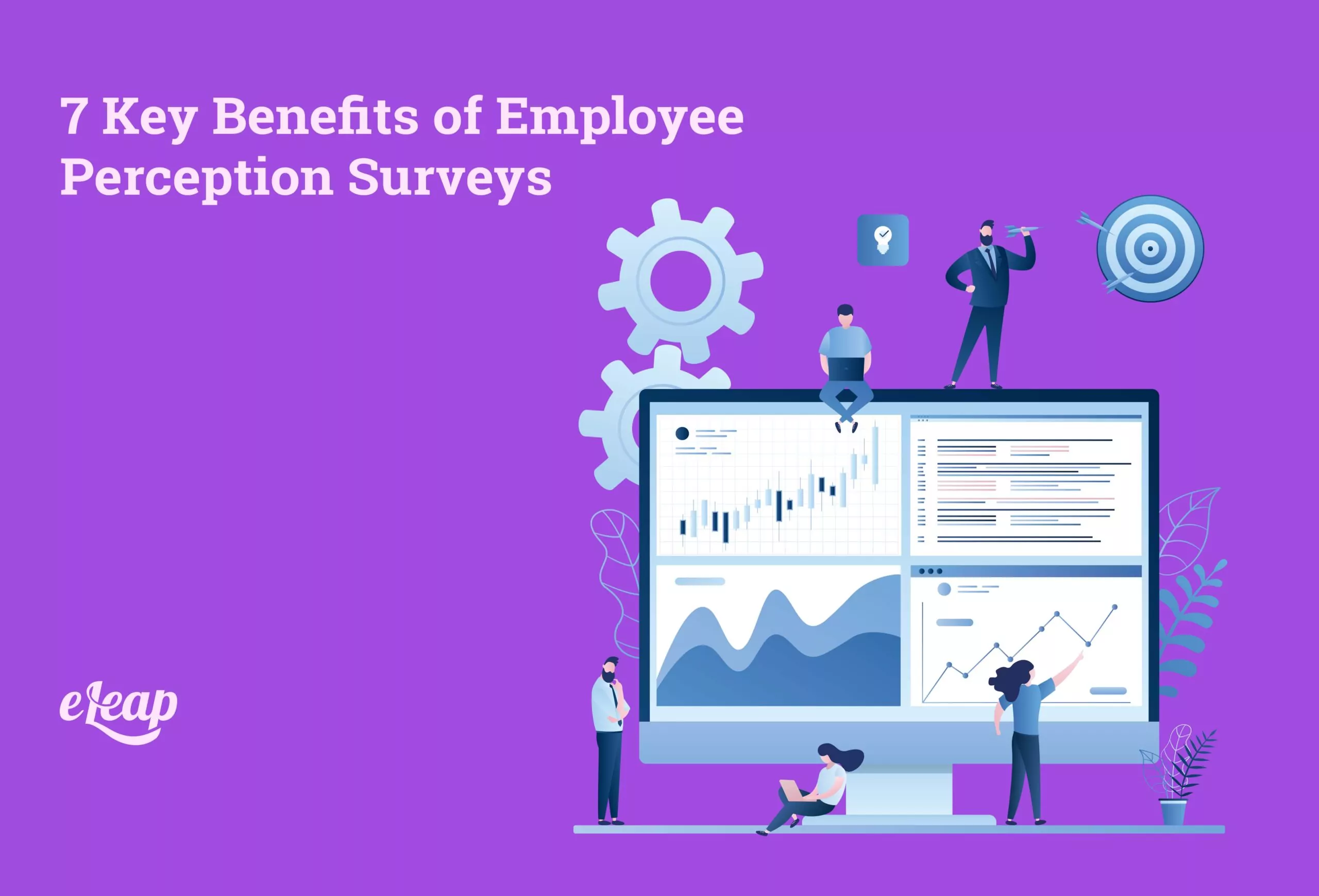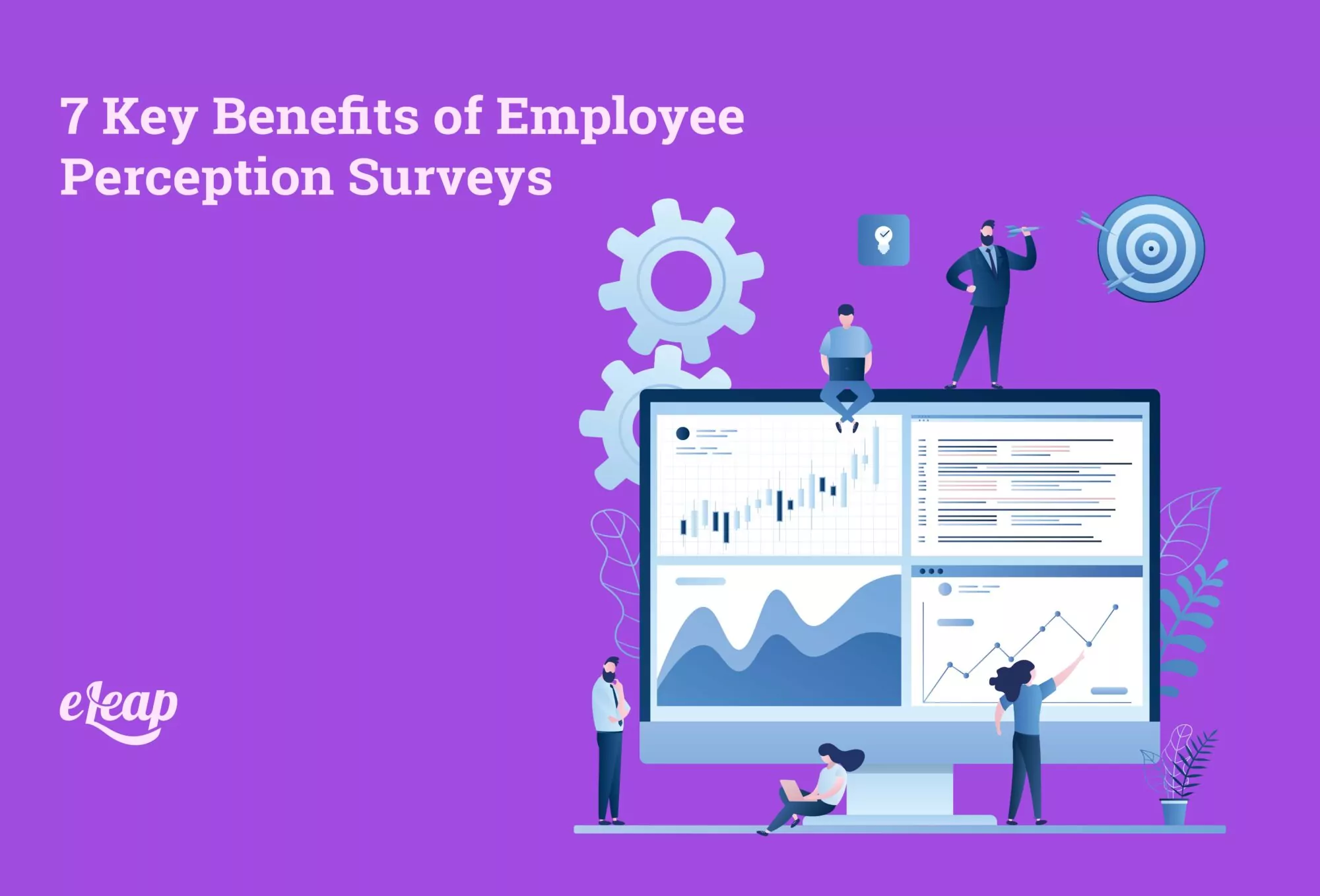7 Key Benefits of Employee Perception Surveys

Employee perception surveys are critical for organizations looking to understand their workforce’s needs, concerns, and feelings. In an environment where business success hinges on the engagement and satisfaction of employees, gaining actionable insights from these surveys can be transformative. By regularly conducting these surveys, businesses can improve morale, streamline communication, and enhance their overall work culture. This article explores the seven key benefits of employee perception surveys and how organizations can leverage them for improved organizational performance. Explore how eLeaP®’s Performance Management Platform can simplify evaluations, boost productivity, and drive measurable results.
What is an Employee Perception Survey?
An employee perception survey is a tool used by businesses to gather feedback from employees regarding their views, experiences, and feelings about their workplace. These surveys often focus on the broader aspects of the company, including workplace culture, leadership, communication, employee engagement, and job satisfaction. Unlike traditional employee satisfaction surveys that primarily gauge contentment levels, perception surveys focus more on how employees perceive their environment, relationships, and the company’s objectives.
These surveys typically include quantitative and qualitative questions that allow employees to express their opinions and personal experiences. The results can highlight trends or underlying issues, providing an invaluable roadmap for managers and HR teams to improve the work environment.
Key Differences from Employee Engagement & Satisfaction Surveys

While employee satisfaction surveys often focus on whether employees are happy with their current work conditions or benefits, employee perception surveys take a broader view. They seek to understand how employees perceive the company, its leadership, and how well the organization aligns with their values and expectations.
Conversely, engagement surveys focus on employees’ motivation to perform at their best and contribute to the organization’s goals. Perception surveys, therefore, provide deeper insights into why employees feel a certain way, revealing emotional and cognitive aspects that impact engagement and retention.
Understanding these nuances is crucial for businesses that aim to create a work environment where employees feel valued, heard, and understood. Employee perception surveys help companies listen to their staff and take actionable steps to improve the employee experience.
7 Key Benefits of Employee Perception Surveys
1. Gaining Actionable Insights into Employee Sentiment
One of the primary benefits of conducting employee perception surveys is understanding how employees truly feel about their workplace. While formal meetings or open-door policies are valuable, they don’t always provide the same level of candor as a well-structured survey. When employees can voice their thoughts anonymously, they are more likely to express their true feelings.
For example, employees might hesitate to share concerns directly with their managers due to fear of retaliation or judgment. Employee perception surveys remove that barrier by providing a platform for sharing feedback without negative consequences. The insights gathered can help organizations make informed decisions that positively impact workplace dynamics, such as enhancing leadership communication or improving office culture.
2. Identifying and Addressing Organizational Weaknesses
Employee perception surveys act as an early warning system, helping companies identify weaknesses in their organization before they snowball into more significant problems. These surveys can reveal patterns of dissatisfaction that might not be immediately apparent to management, such as low morale, inadequate communication, or issues with work-life balance.
With this information, organizations can proactively address issues before they lead to higher turnover rates or diminished productivity. For example, if a survey reveals that employees feel underappreciated or lack recognition, management can quickly implement strategies to improve employee recognition programs, thus preventing disengagement.
3. Enhancing Employee Engagement and Empowerment
Employee engagement is among the most significant drivers of productivity and organizational success. Employees who feel engaged are more likely to be committed to their work and motivated to contribute toward the company’s goals. Employee perception surveys provide insights into the factors influencing engagement levels, such as job satisfaction, leadership effectiveness, and team dynamics.
By actively listening to employees and acting on their feedback, businesses can empower their workforce, making them feel valued and involved in decision-making. For instance, implementing suggestions from perception surveys can lead to stronger relationships between managers and their teams, fostering a sense of ownership and commitment to the company’s success.
4. Improving Employee Retention by Addressing Key Concerns
High employee turnover is costly for any business. It leads to losing talent, reduced productivity, and increased recruitment expenses. Employee perception surveys can help companies identify the underlying causes of turnover by asking employees about their job satisfaction, career development opportunities, and relationships with leadership.
Organizations can address specific issues that lead to employee dissatisfaction by acting on the feedback provided in these surveys. For example, if employees feel there are limited opportunities for career growth, providing better training, mentorship, and clear career progression paths can improve retention. Addressing these concerns early shows employees that the organization values them, leading to increased loyalty and lower turnover rates.
5. Strengthening Communication Between Leadership and Staff
A significant benefit of employee perception surveys is improving communication between management and employees. Employees often feel disconnected from leadership, especially in larger organizations. Perception surveys allow management to understand how employees view their leadership team and identify areas for improvement.
For example, if survey results indicate that employees feel disconnected or uninformed about company initiatives, leaders can take steps to enhance communication channels. Whether through regular town hall meetings, more transparent decision-making, or providing employees with regular updates on company performance, improving communication helps build trust and aligns the team toward common goals.
6. Fostering a More Inclusive and Collaborative Workplace Culture
Fostering an inclusive culture is crucial for maintaining employee satisfaction and productivity in today’s diverse workplace. Employee perception surveys can reveal how inclusive employees feel about the organization and whether there are gaps in diversity, equity, and inclusion efforts.
By regularly collecting feedback on issues such as team collaboration, respect for diverse perspectives, and organizational inclusivity, businesses can better understand where they need to improve. This stage could lead to implementing diversity training programs, enhancing policies related to work-life balance, or promoting inclusivity in leadership roles.
Survey results show that such initiatives improve workplace culture and boost employee morale and productivity, as employees feel more valued and supported.
7. Driving Business Success with Data-Driven Decisions
The most significant advantage of employee perception surveys is that they provide data-driven insights that can inform business decisions. Rather than relying on anecdotal evidence or gut feelings, companies can make informed, data-backed decisions to improve their operations.
For example, if surveys indicate that employees are dissatisfied with their current tools or resources, organizations can take action by upgrading software or providing additional training. Similarly, survey data can help leaders identify areas where the company excels, allowing them to double down on successful strategies. By relying on employee feedback, businesses can ensure they are moving in the right direction.
Best Practices for Running Effective Employee Perception Surveys
Crafting Surveys that Are Clear, Concise, and Relevant
The effectiveness of an employee perception survey largely depends on how well the survey is designed. The questions should be clear, concise, and tailored to address specific areas of the organization. A well-crafted survey will capture meaningful feedback without overwhelming employees with long, confusing, or irrelevant questions.
Survey tools like eLeaP can help organizations create custom surveys tailored to their needs. By using the right questions and formats, companies can gather valuable data that speaks to the specific challenges they are trying to address.
Keeping Surveys Anonymous to Ensure Honest Feedback
One key to successful employee perception surveys is maintaining anonymity. Employees are likelier to be honest when they know their responses will not be linked to them. Anonymity fosters a sense of safety, allowing employees to share their true feelings without fear of retaliation.
Ensuring Frequency Without Overloading Employees
It’s essential to find a balance regarding survey frequency. Too many surveys can lead to fatigue, which might diminish the quality of the feedback. Instead, surveys should be conducted quarterly or bi-annually to track trends while giving employees enough time to act on the input.
Overcoming Common Challenges in Employee Perception Surveys
Ensuring Confidentiality and Building Trust
Employee perception surveys are effective only when employees trust that their responses will remain confidential. Clearly communicate how you will use the feedback and emphasize that the process is entirely anonymous. Building this trust is critical to the success of the surveys.
Overcoming Survey Fatigue
Survey fatigue can occur when employees are asked to complete surveys too often. To avoid this, surveys should be short and to the point, focusing only on the most critical aspects of the employee experience. Additionally, ensure that each study provides clear value and leads to meaningful change.
Conclusion
Employee perception surveys offer businesses a wealth of insights that can drive positive organizational change. By understanding employees’ feelings, businesses can improve engagement, retention, and overall company culture. The actionable feedback from these surveys allows organizations to make informed decisions that benefit employees and the business. When executed thoughtfully, employee perception surveys can be one of the most powerful tools in a company’s toolkit.
By leveraging surveys in a strategic, data-driven way, businesses can create a workplace where employees are more engaged, satisfied, and committed to their roles, ultimately leading to better business outcomes.